Citations:
Paley, G. L., Sheldon, C. A., Burrows, E. K., Chilutti, M. R., Liu, G. T., & McCormack, S. E.
(2015). Original article: Overweight and Obesity in Pediatric Secondary Pseudotumor Cerebri Syndrome. American Journal Of Ophthalmology, 159344-352.e1. doi:10.1016/j.ajo.2014.11.003
Clara L., A., Aley, T., & Mário Luiz Ribeiro, M. (2015). Factors affecting visual loss and visual recovery in patients with pseudotumor cerebri syndrome / Fatores que influenciam na perda e na recuperação visual de pacientes com a síndrome do pseudotumor cerebral. Arquivos Brasileiros De Oftalmologia, (3), 175. doi:10.5935/0004-2749.20150045
Pseudotumor Cerebri (Idiopathic Intracranial Hypertension)
More Information
2 Types
Secondary
Caused by medications or other preexisting conditions
(Paley et al., 2015)
Primary
Idiopathic, occurs without a known cause. Currently thought to be associated with obese/overweight females.
(Paley et al., 2015)
Concerns with Disease
Possible retinal hemorrhages
(Clara & Ribiero, 2015)
Possible visual field loss due to papilledema
(Clara & Ribiero, 2015)
Causes an increased pressure on the optic nerve resulting in permanent damage
(Clara & Ribiero, 2015)
Epidemiological Data: Correlational Study by Clara and Ribiero (2015)
Results
Associated with vision loss-->86%
Associated with headaches-->80%
Associated with obesity or being overweight-->increased BMI of 32 kg/cm^2 (class I obesity)
Associated with females-->6:1 ratio (F:M)
Study Parameters
Best Corrected VA
Time from Original Diagnosis
Visual Symptoms
History of Hypertension
Body Mass Index (BMI)
Weight
Sex
50 Subjects (43 F, 7 M)
Differential Diagnosis: Must be a form of Pseudotumor Cerebri
Increased ICP without neurological findings
Major indication of PTC
(Clara & Ribiero, 2015)
Possibility of some visual field loss
Patient was unable to obtain a distance VA better than 20/40 suggesting that there must be ocular disease present and possibly some visual field loss
(Clara & Ribiero, 2015)
No clear indication of cause-->idiopathic
Correlational studies such as from Clara and Ribiero (2015) suggest that the cause of pseudotumor cerebri is correlated with females, obesity, hypertension, and increased BMI
(Clara & Ribiero, 2015)
Not glaucoma
IOP's are within normal range
(Clara & Ribiero, 2015)
Patient MRN: 111716
Lumbar Puncture
Increased Intracranial Pressure (ICP)
Findings
Vitreous Opacities
Possible Posterior Vitreous Detachment (PVD)
IOP
OS: 16 mmHg
OD: 15 mmHg
Visual Acuity
Near Aided with Spectacles
OU: 20/20
OS: 20/25
OD: 20/30
Far Aides with Spectacles and Pinhole
OS: 20/40
OD: 20/40+2
Far Aided with Spectacles
OU: 20/40+2
OS: 20/70-1
OD: 20/60-1
Family History
Mother
Hypertension
Father
Diabetes
Laser Eye Surgery for "Hole in Eye" ~20 years ago
Medications and Supplements
Iron
Vitamin D
Ferrous Fumarate (324 mg Tablet)
Valsartan (160mg Tablet)
Bisoprolol Fumarate (10mg)
Albuterol
Previous Diagnoses
Asthma
Presbyopia
Hypertension (150/95)
Sleep Apnea
Papilledema
Pseudotumor Cerebri
Chief Complaint: Flashes and Floaters
African American
49 years old
Female









